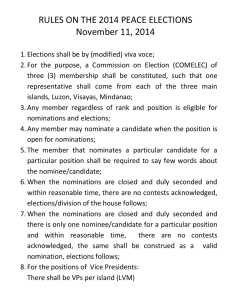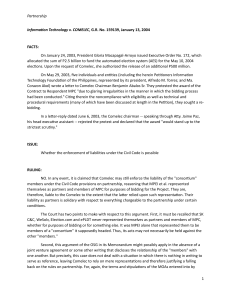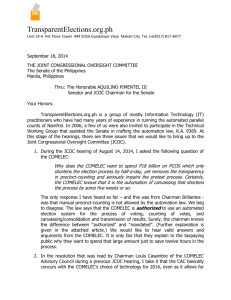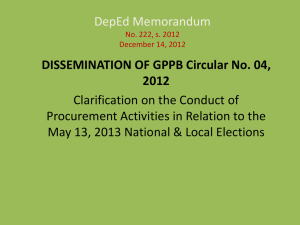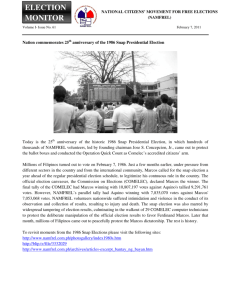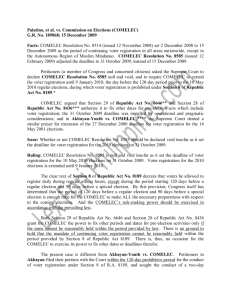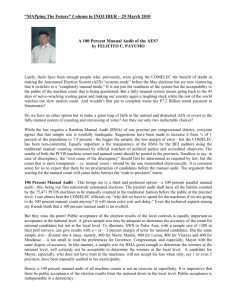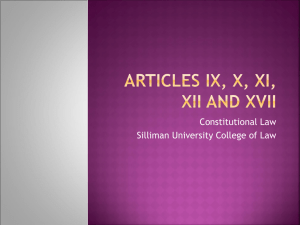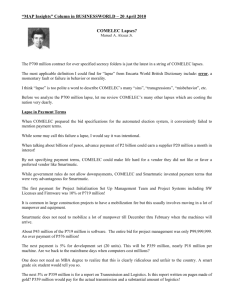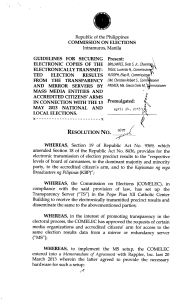Annex 9 - Institute For Political and Electoral Reform
advertisement
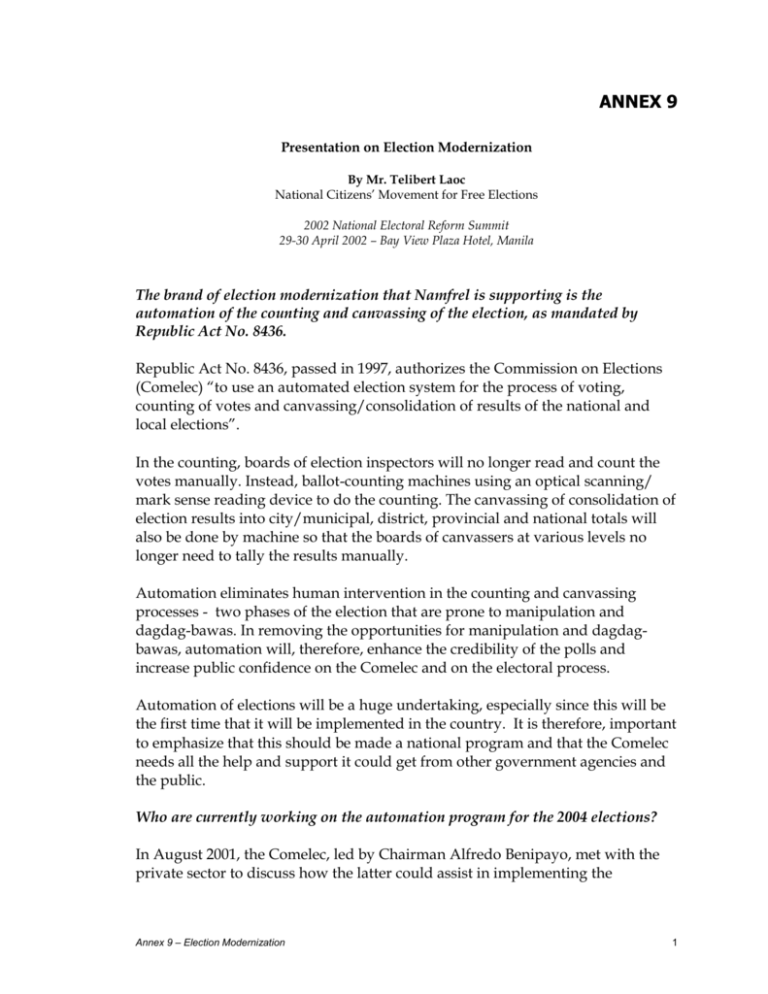
ANNEX 9 Presentation on Election Modernization By Mr. Telibert Laoc National Citizens’ Movement for Free Elections 2002 National Electoral Reform Summit 29-30 April 2002 – Bay View Plaza Hotel, Manila The brand of election modernization that Namfrel is supporting is the automation of the counting and canvassing of the election, as mandated by Republic Act No. 8436. Republic Act No. 8436, passed in 1997, authorizes the Commission on Elections (Comelec) “to use an automated election system for the process of voting, counting of votes and canvassing/consolidation of results of the national and local elections”. In the counting, boards of election inspectors will no longer read and count the votes manually. Instead, ballot-counting machines using an optical scanning/ mark sense reading device to do the counting. The canvassing of consolidation of election results into city/municipal, district, provincial and national totals will also be done by machine so that the boards of canvassers at various levels no longer need to tally the results manually. Automation eliminates human intervention in the counting and canvassing processes - two phases of the election that are prone to manipulation and dagdag-bawas. In removing the opportunities for manipulation and dagdagbawas, automation will, therefore, enhance the credibility of the polls and increase public confidence on the Comelec and on the electoral process. Automation of elections will be a huge undertaking, especially since this will be the first time that it will be implemented in the country. It is therefore, important to emphasize that this should be made a national program and that the Comelec needs all the help and support it could get from other government agencies and the public. Who are currently working on the automation program for the 2004 elections? In August 2001, the Comelec, led by Chairman Alfredo Benipayo, met with the private sector to discuss how the latter could assist in implementing the Annex 9 – Election Modernization 1 automation program. This meeting marked the beginning of a partnership between the Comelec and the private sector. The following organizations are currently involved in helping the Comelec in the automation program: Advertising Board of the Philippines (AdBoard); Ad Foundation; Ateneo de Manila University (ADMU); Bishops-Businessmen’s Conference (BBC); Catholic Educational Association of the Philippines (CEAP); De La Salle University (DLSU); Institute of Electronics and Electrical Engineers, Inc. (IEEE); Information Technology Foundation of the Philippines (ITFP); Makati Business Club (MBC); Namfrel; Operations Research Society of the Philippine (ORSP); Philippine Computer Society (PCS); Procurement Watch, Inc.; Purchasing & Materials Management Association of the Philippines (PMMAP); SyCip Gorres Velayo & Company (SGV); Student Catholic Action of the Philippines (SCAP); NASSA-CBCP; and Web Philippines. From the government sector, the Department of Science and Technology (DOST) and the University of the Philippines (UP) are also providing assistance to the Comelec as members of the Advisory Council, which is created under R.A. 8436. Other government agencies such as the Department of Finance (DOF), Department of Budget and Management (DBM), the National Computer Center (NCC), the National Economic Development Authority (NEDA) are also providing assistance and significant insights on various aspects of the automation program. Namfrel also believes that RA 8436 can be implemented without amending it. The 23 specific features of the automated system, in Section 7 of RA 8436, are not mandatory. The law only states that the system will have these 23 features only “as far as practicable”. In implementing the automation program, Comelec will adopt some of these features especially those that will enhance the security of system and safeguard the credibility of the electoral process. With 25 months to before the 2004 Presidential and General Elections, There is enough time to implement the law. To date, Comelec is making significant headway towards the implementation of the program in 2004. Attempts to amend the law may derail the schedule of the Comelec. More importantly, these attempts may also provide uncertainly in the planning and set back the preparations for the program. With regard to the proposals to amend RA 8436 pending in Congress, Namfrel gives the following comments on major issues: Annex 9 – Election Modernization 2 a. On the discretion for Comelec to determine coverage of implementation for the 2004 elections We do not agree that Comelec be given discretion on determining the coverage of the automation program. Besides, elections officials and boards of election inspectors in the areas were counting and canvassing will be manual will be vulnerable to pressures for manipulation. b. On the reversion to the manual system in case of a systems breakdown, whether nationwide or in affected areas One of the main features of the automated counting and canvassing system is that it is stand-alone. This means that a systems breakdown will be on per machine basis. Moreover, the machines will be deployed on a per municipality basis or in the case of the National Capital Region (NCR), one machine will be deployed for a group of precincts. In case of system breakdown, the Comelec could then borrow machines from a nearby city or municipality thus making it unnecessary for the Comelec to revert to the manual system. Furthermore, in case of problems that are external to the machine, the Comelec could provide for contingency measures that will address these problems and still ensure the integrity of the electoral process. For example, if there was an error in the printing of ballots such that the machine could not accurately read them, like what happened in Pata, Sulu in 1998, we propose the following: for Comelec to declare a failure of election in the affected area/s and call for a special elections using correctly printed ballot. c. Implication of coding the ballots for every precinct Coding of ballots by city or municipality and by district in the case of the NCR may be sufficient as far as safeguards are concerned. Ballot coding for every precinct would have a direct impact on the printing of ballots as it will entail an estimated 200,000 ballot faces, which would be equivalent to the total number of precincts nationwide. For the 2004 elections, the data on the number of precincts and registered voters will only be finalized in the first quarter of 2004. Comelec, therefore, may not have enough time to print the ballots with these number of ballot faces. Furthermore, printing these number of ballot faces will be very costly. Annex 9 – Election Modernization 3

